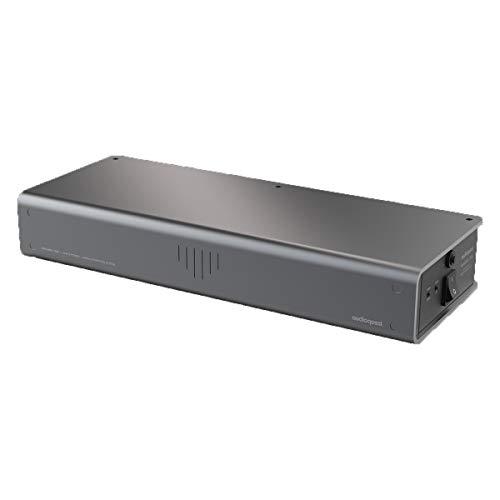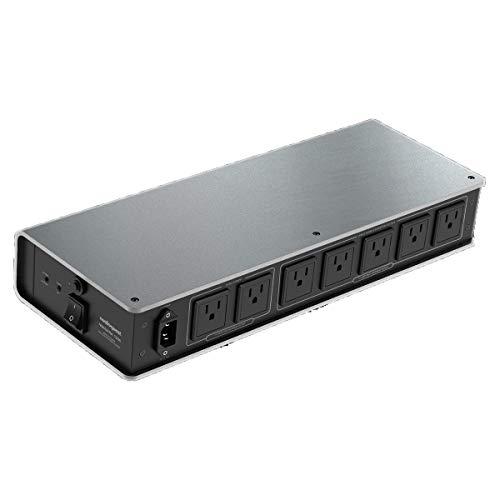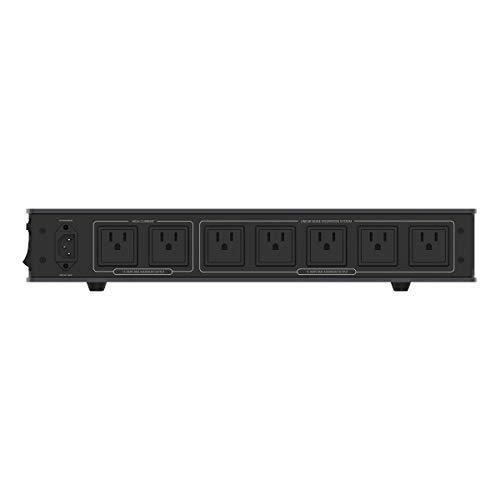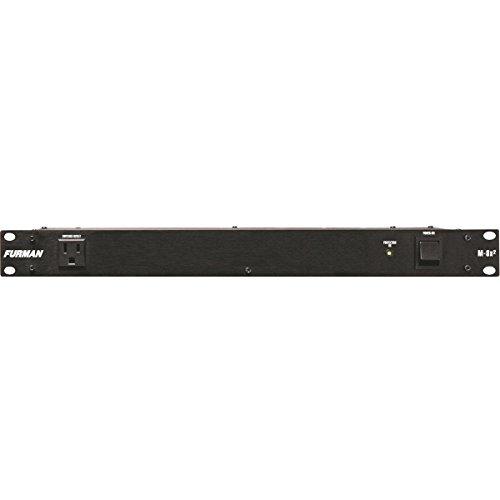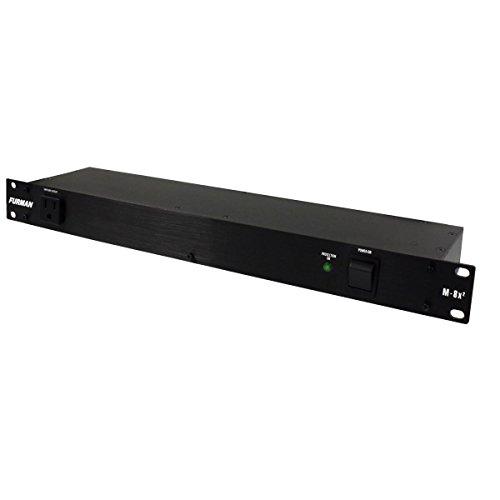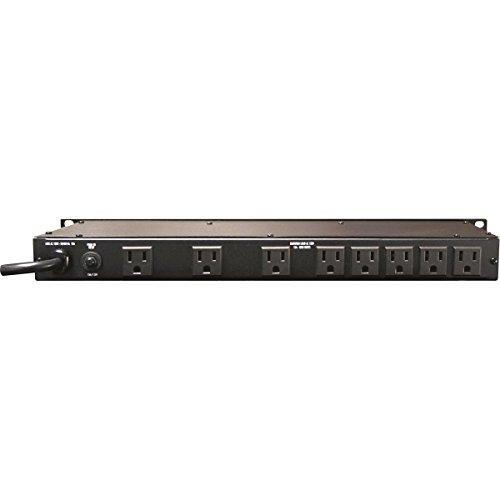Best Home Theatre Power Manager in 2025
Power managers’ influence on home theatres’ sound is sometimes hotly debated. Some swear that the sound is much more precise and more differentiated – others speak of imagination. Why do you need a home theatre power manager?
That’s a question one might ask anyway. The power grid we use every day was conceived in the gray prehistory of electricity – over 100 years ago. And the type of equipment to be supplied with voltage back then differs significantly from today’s requirements. Light bulbs and electric motors have different requirements than high-quality home theatres. Modern amplifiers require enormous peak voltages, even at moderate playback levels, to operate dynamically accurately. In addition, the density of radio frequencies and other sources of interference, which are interspersed in the power grid, has increased dramatically. Only on the power grid itself, ultimately, nothing has changed. This one-sided progress has now resulted in problems such as underpowered devices and all kinds of interference voltages in the signal path. Interspersed noise in particular can hurt the listening experience.
What do Home Theatre Power Managers do?
A power manager or power conditioner ensures that only “clean” electricity reaches your home theatre system – and all other technical devices – without voltage fluctuations. This should lead to an improvement of the sound.
Electrosmog and voltage fluctuations disturb home theatres
In theory, your power company supplies electricity with a constant mains frequency. However, there’s no doubt that fluctuations in voltage do occur: you’re not always drawing smooth volts from your wall socket. Disturbances can be due to the power company, but they can also come from neighbors in apartment buildings or your appliances. Even your home theatre system itself can cause interference in the power grid.
In addition, we are surrounded everywhere by electromagnetic radiation: so-called electrosmog. This, too, is said to mess up the frequencies in the room and cause a music system to not perform to its full potential.
A home theatre power manager “cleans” the electricity
Home theatre power managers are supposed to be able to eliminate all these disturbances in the room or at least weaken them considerably. Therefore, they are not only connected directly to a device or connected between the home theatre system and the power outlet. Instead, one or more power managers are distributed around the room or the entire apartment. There they intercept high-frequency interference and prevent voltage peaks: In this way, they are intended to create optimal conditions for undisturbed development of the full sound variety. There are both power managers, through which the electricity flows before it reaches your system, for example, and so-called parallel filters, which are simply plugged into the power strip next to various other connections.
Undisturbed sound enjoyment is the result
When chaotic electricity voltages have been calmed down and the “dirty” electricity has been cleaned, speakers should finally be able to show what they can do. Power managers, therefore, do not directly influence home theatre systems, but create the framework conditions so that their sound can unfold optimally in the room and be perceived by us listeners in the best possible way – completely undisturbed and pure.
What to Consider when Buying a Home Theatre Power Manager or Power Conditioner
Similar to any other product on the market, not every power manager is right for your needs. Let’s take a look at some key factors to consider when buying a power manager or power conditioner for your home theatre.
Budget
First, you need to consider how expensive or cheap your home theater system is. Based on the value of the home theater system, it becomes clearer how much money you should spend on the home theater power manager. More expensive power managers offer more outlets and ensure better filtering and protection. Some cheaper alternatives may offer fewer outlets and not be good at their functions.
Number and position of power outlets
Power managers usually have an even number of outlets ranging from 6 to 12. It is advisable to buy a power manager whose number of outlets depends on the number of devices you need. Make sure you buy one with more outlets than you need in case you need more space later. Also, make sure the outlets are well spaced due to the different plug sizes of different devices.
Size
The more sockets, the bigger the power supply needs to be. Users should make sure they have the right space for a particular power manager. Some power managers can be mounted on the wall, while others are designed to be placed on shelves.
Filtration Level
There are two main types of ratings. The first is clamping voltage and the second is energy absorption. The clamping voltage refers to the voltage level at which a power manager’s overvoltage protection will trigger an extreme voltage shutdown. To protect your home theater and other equipment, the rating of your power manager should be between 120V and 400V or more. Energy absorption power, as the name implies, is the power that a power manager can absorb and filter. The ideal value is at least 500 joules.
Best Home Theatre Power Managers to Buy
AudioQuest Niagara 1200
Best for Audiophiles
- Common to all Niagara products the 1200 features the non-sacrificial surge protection and over-voltage shutdown
- Withstands surges and spikes up to 6000 volts
- The 1200 can now sit on a shelf like a component with all the in and out cables in the back
- Optimized for low-noise directionality
The sources of potential interference voltages are numerous. Not to mention electromagnetic interference and the increasing density of radio frequencies whizzing through the domestic airspace. But AudioQuest is known not to be deterred by such challenges, preferring instead to offer high-quality solutions.
Niagara 1200 looks and feels like a high-end device. The design is minimalist and simple, yet very attractive and elegant. It looks super-clean. On the right side, there is only a massive power switch and two status LEDs. The blue LED signals Niagara’s operating status, while the red LED provides information about the over-voltage protection activity. On the back, there are seven outlets – two high-current outlets (for connecting amplifiers, powered speakers, subwoofers) and five linear filtered outlets for connecting PCs, streamers, DVD/Blu-ray players, TVs, etc. This unit is primarily designed for audio systems, but can also be used for home theater systems. All 7 outputs feature AudioQuest’s Ground Noise-Dissipation System and are equipped with ultra-linear filter capacitors.
It’s no longer a secret. The Niagara series is one of the best home theatre power manager solutions money can buy. Unsurprisingly, the 1200 model is no exception. After connecting our full reference setup to the AudioQuest Niagara 1200, the sonic improvements are impossible to deny. The reproduction is more three-dimensional and has more depth. Transients also benefit immensely and especially percussive signals become noticeable. In general, all signals gain in dynamics and any trace of background noise in idle mode is also a thing of the past. We recommend everyone to simply convince themselves.
Panamax M5400-PM
Mid-priced Power Manager
The Panamax M5400-PM is a mid-range power manager that comes with a lot of cool features you’ll want when putting together a powerful home theater system. The voltage regulation and monitoring circuits provide the user with added value that is proven in practice. The Panamax M5400-PM is a powerful surge protector and AC line filter. Like most AC power managers in its class, it is capable of removing noise and producing a quieter noise floor.
Furman M-8×2
Budget-pick Power Manager
- AC noise filtering reduces RFI/EMI, Spike & surge protection ensures equipment stays safe & power stays clean,
- 15 amp rating with circuit breaker and "Protection OK" Front Panel Indicator to let you know that your equipment is being protected
- 9 Total outlets: 8 rear panel outlets (including 3 with "wall wart" spacing) and 1 front panel convenience outlet
- Filtration rating greater than 23 dB, 200 Khz to 10 Mhz, perfect for instrument rigs, home recording, DJ equipment, pro audio rigs and home entertainment systems
M-Series power managers protect your sensitive electronic equipment by combining high voltage varistors to suppress surges and spikes. The fast response suppression circuit reacts quickly and limits the overvoltages to a safe level
Although some units may occasionally produce noise, white noise, and hum due to their internal design, the M-8X2 remains useful and reliable in any usage.
FAQs on Home Theatre Power Manager
Does my home theatre sound better with a power manager?
Many people report enthusiastic results, they speak of much higher dynamics, finer differentiation of individual tones, and physicality of instruments and voices. The enjoyment of music in one’s own home is said to be very close to that at a concert and make it possible to experience music in a completely new way.
Is there also criticism of home theatre power managers?
Skeptics argue that these are subjective auditory impressions that cannot be verified in this way. They counter that technical devices have no problem with the typical low voltages in the power grid. And that in some cases even corresponding interference suppression filters – or components that perform the same function – are integrated into the device itself or in the power strips anyway.
Can power managers degrade the sound of your home theatre?
The sound of your home theatre can even be worsened by bad power managers. Explanations for it could be that net filters attenuate sometimes electricity peaks too strongly – and thus for example final stages in their effect limit. In addition, power managers themselves can produce electromagnetic waves.
How does a power manager influence the brain?
Even more difficult to prove than the influence of a power manager on the home theatre is its influence on you as a listener. This is because the reduction of electrosmog is also supposed to lead to your brain being less overloaded – a condition that you are not even consciously aware of. As a result, sounds should be able to be processed properly by your ears again. Again, the ubiquitous presence of electrosmog is undisputed. And also health impairments are said to be caused by too strong electromagnetic radiation. However, the extent to which all of this affects your listening experience must be judged by each individual.
Can we connect all studio components to one power manager?
Yes, we can connect all the studio components to one air conditioner if there are noise problems and the source of the noise cannot be found. Before you buy a power manager, you should check if the equipment in the studio is causing the noise.
What is the difference between a power manager and a surge protector?
Although they look similar, a power manager is not the same as a surge protector. A power manager filters power, eliminates noise, and also provides surge protection. High-quality power managers can also regulate voltages.
Surge protectors are power strips that protect connected devices from surges and spikes, nothing more. They channel the extra energy from a surge into a ground wire to dissipate it and prevent connected electronics from burning out. Surge protectors do not filter electricity. They only protect from voltage spikes. In other words, surge protectors only provide one type of protection from electrical damage. For general electronics, a surge protector is more useful than a power manager.
A power manager offers more protection than a surge protector. Most power managers offer two main functions: a surge protector and a noise filter.
Do power manager and power conditioner mean the same thing?
Both terms describe the same thing and are often used as synonyms.
